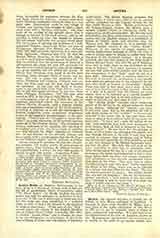

Ancren Riwle, or REGULA INCLUSARUM, is the name given to a thirteenth-century code of rules for the life of anchoresses, which is sometimes called “The Nuns‘ Rule”. In Middle English the word ancren was used for solitaries, or anchorites of both sexes; but in this case it refers only to ladies who had left the world and were established in a secluded place, in order to lead a life devoted to the practices of religious observance. Of the text of this “Rule” several copies are extant in the English libraries. One at Corpus Christi College, Cambridge (MS. 402), is entitled “Ancren Wisse” and is thought by some to be an abridgment, or adaptation, of the Latin tract of Simon of Ghent who was Bishop of Salisbury (1297-1315). The British Museum possesses five copies, three of which were collated for the printed edition published for the Camden Society by the Rev. James Morton in 1852. Besides publishing the old Norman-English version, Mr. Morton gave a modern English version or translation which was reprinted in a small volume in 1905. Mr. Morton, in his introduction, has given many reasons for rejecting the notion that the English version is a translation of Simon of Ghent’s tract, and considers that the Museum Cott. MS., Cleopatra C. vi, is probably the original English version of the “Ancren Riwle”. Moreover, in the opinion of many experts, the curious Anglo-Saxon language in which the code of rules is written seems to require an earlier date than the close of the thirteenth century. It is thought probable that the real author of the little book is Bishop Richard Poore, who held the see of Salisbury from 1217 to 1229, when he was translated by the Pope to Durham. It is right, however, to mention the fact that some writers consider that the time of the composition of the “Rule” must be put at a later date. Although there is nothing whatever in the work to warrant the assumption, it has usually been taken for granted that it was composed for the nuns who dwelt at Tarrent in Dorsetshire. Bishop Poore was born in that place, and a sister of his is said to have become a nun in that convent. Be that as it may, it is certain that the Bishop, for some reason, came to be regarded as a “second founder” of the convent and that in his last sickness he journeyed to Tarrent and died there in 1237.
The “Ancren Riwle” contains many interesting details of the life led by the solitary ladies for whom it was written. Although the “ancress” was alone in the strict sense, that is, she inhabited her cell or cells alone, except for the “maiden” or servant who attended to her wants, still, in this case, there were three or more of these solitary ladies living under the same roof. “I know not”, says the author of the rule, “any anchoress that with more abundance, or more honor, hath all that is necessary to her than ye three have”. We also learn that the convent, or house, of these ladies was adjoining the church, and that through windows in the cells of each they were enabled to practice their devotions and to follow the services and especially the Holy Sacrifice, as well as pay their homage to the Blessed Sacrament hanging over the altar. The daily life and work of the nuns, according to this rule, is simplicity itself. After having begun the day by a visit to the Blessed Sacrament, the sisters were instructed to fall on their knees before their crucifixes and occupy themselves with salutations to Our Savior represented before their eyes on the Cross. They were then to salute Our Blessed Lady with “five ayes”, before beginning the Hours of her Office, which were to be followed by a Litany and the Office for the Dead. The day was mostly occupied by prayer. The author admits that this and the keeping of “the ten old Commandments” constitute a hard fashion of life, but adds that “nothing is ever so hard that love doth not make it tender and soft and sweet”.
FRANCIS AIDAN GASQUET

